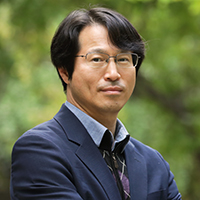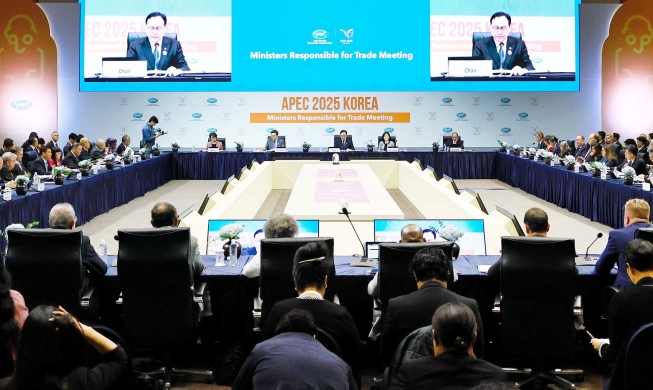
By Lee Young-chae
Professor at Keisen University
The recent conflict provoked by an exhibition at Japan's Industrial Heritage Information Centre reminds me of my visit in April last year to Hashima (Battleship) Island.
At the time, I visited the island with Korean and Japanese civic groups as guests of the Korea-Japan Peace & Green Boat 2019 Event to mark the centennial anniversary of Korea's March First Independence Movement and the establishment of the Korean Provisional Government in Shanghai, China.
Before departing, I saw a promotional video on the island at a digital museum for Hashima near Nagasaki Port that said, "Not only Japanese but also a lot of foreigners worked at Hashima Coal Mine, and they were all on good terms with each other from 1944 until (World War II) ended." There was no mention of the forced labor, harsh working conditions and discrimination endured by Korean workers. While boarding the boat to the island, which was 19 km southwest of the port, a variety of videos were screened in Japanese to promote how the island's industrial heritage, including the shipyard of Mitsubishi Heavy Industries, contributed to the modernization of Japan. Again, the pain of war and laborers from Japan's colonies were not mentioned at all.
Approximately 40 minutes after departure, we sighted the island, which resembled a ghost battleship floating with the ruins of apartment buildings. Japanese might consider Hashima their proud Meiji industrial sites recognized as World Heritage but to Koreans, it is a horrific site of forced labor that nobody wants to remember or even step on. After arrival, we were taken by a guide around the island for about 30 minutes to see a few facilities from a far distance such as apartment buildings Nos. 30 and 31, the stairs to a coal mine and a conveyer belt used for coal stock.
The middle-aged guide, a native of the island, stressed that modern-style apartment complexes were built on the island, and mentioned the sweat and sacrifice of workers and a residential community there. On the poor working conditions at the mine, he said, "Workers went 600 meters underground by elevator and then walked down another 400 meters. The temperature inside was over 40 Celsius with humidity of more than 95%. Inside the mine, there was always the risk of an underground accident such as a gas explosion or collapse. Underground water often filled the mine and oxygen was scarce." Everything was explained in Japanese, and interpretation in Korean was not allowed. According to the event's staff, when applying to visit the island, visitors had to agree to the preconditions of following the guide's instructions with no interpretation in Korean. With that in mind, I had to secretly interpret what the guide said for attending Korean journalists.
Nothing was mentioned about the forced labor and discrimination that Korean workers suffered, either by the guide or at any of the tour courses. Visitors to Hashima will thus not learn about the sacrifice and forced labor suffered by Koreans, Chinese or other non-Japanese workers on the island. Instead, tourists will only remember the inclusiveness and generosity of Japanese society that accepted foreign workers as members of the community without discrimination.
Battleship Island has been made into a place for the distortion and further manipulation of history; the island could even make one assume that Korea is groundlessly attacking Japan over the forced labor issue. The island exclusively displays Japan’s advanced technology that gained World Heritage status and the lives and sacrifices of Japanese workers and commoners who maintained a community of solidarity. Given the absence of any mention of Japan's history in World War II and its industrial facilities, how many Japanese, if any, would know of the existence of Koreans forced to work here and who suffered discrimination and mistreatment? Thus the island is apparently turning into a place for history distortion and manipulation, as all explanations and tourist venues emphasize only the positive side of the facilities while hiding the dark history of Japan's colonial rule.
Since designating in 2015 the 23 Meiji industrial sites as World Heritage including the island, the UNESCO World Heritage Committee (WHC) has consistently urged the Japanese government to faithfully implement the WHC's recommendation of Tokyo preparing an "interpretive strategy" to allow understanding of the "full history" of each site. Not only the Korean government but also Korean and Japanese civic groups have all strongly requested faithful implementation of the recommendation, but Tokyo has taken no concrete steps.
Exhibiting the history of the Meiji industrial facilities, including Hashima, the information center was initially opened on March 31 in central Tokyo, not Nagasaki. This decision apparently had in mind the 2020 Tokyo Summer Olympics as part of Japan's promotional strategy to target overseas visitors to the country for the Olympics to promote the World Heritage-designated industrial facilities of Japanese companies, whitewash Japan's history of war crimes and change the companies' image. When the Tokyo Olympics Organizing Committee granted de facto approval of the use of the "rising sun" flag inside the stadiums, such companies might have considered using the Olympics as a timely opportunity to lessen their negative image of aggression related to war and militarism. In that environment, the history of forced labor by Koreans might have gained little attention.
The Tokyo Olympics, however, was postponed due to the coronavirus pandemic. Declaring a state of emergency, the Japanese government had no choice but to close the center temporarily. Due to its failure to effectively respond to the pandemic, the Abe administration saw its approval rate fall to 30%, and public opinion polls said about 69% of Japanese oppose a fourth consecutive term for Prime Minister Shinzo Abe. The center on June 15 was opened to the public amid discussions on a post-Abe leadership and the clearly declining influence of right-wing groups such as the Japan Conference, also called Nippon Kaigi in Japanese.
The information center partially displays documents on forced labor and quotes the WHC's decision, but clearly presents itself as a blatant violator of the WHC recommendation. Thus the center deserves criticism as merely conducting "noise marketing" by exclusively showing the testimonies of island residents who deny forced labor occurred on Hashima. This is nothing but a trick to provoke opposition to Korea and gain the attention of the Japanese people and right wingers to bolster the support base of the Abe administration.
The director of the information center is Koko Kato, an old friend of Prime Minister Abe who shares his idea of historical revisionism. Through the Abe administration, they will probably set up strategies to revive Japanese imperialism in carrying on the legacy of Shoin Yoshida, a 19th-century intellectual who advocated Japanese expansionism, getting sites of the Meiji Industrial Revolution designated UNESCO World Heritage, pushing forward a new security law, hosting the Tokyo Olympics and achieving constitutional revision. The pandemic has led to the scrapping of all of these plans. Like an island left in ruins, the information center could become an exhibition hall showing the ruins of historical revisionism and wander aimlessly like a ghost ship. My hope is that the center can reflect the historical truth and take its rightful place.
Lee is a professor of international social studies at Keisen University in Tokyo.
Translated by Korea.net staff writer Yoon Sojung.
